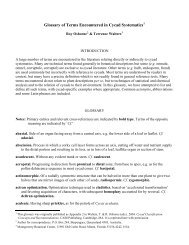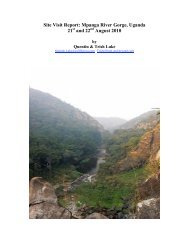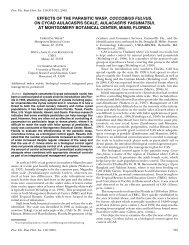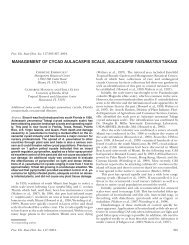Cycas-circinalis-cas.. - Cycad Specialist Group
Cycas-circinalis-cas.. - Cycad Specialist Group
Cycas-circinalis-cas.. - Cycad Specialist Group
You also want an ePaper? Increase the reach of your titles
YUMPU automatically turns print PDFs into web optimized ePapers that Google loves.
3.2. Documenting C. <strong>circinalis</strong> trade<br />
We located three <strong>Cy<strong>cas</strong></strong> dealers who were interviewed in the district of<br />
Virudhanagar( Tamil Nadu), one of the main markets for medicinal plants in South India<br />
to document trade in C. <strong>circinalis</strong>. Semi-structured interviews were used to ask dealers 10<br />
questions in (Appendix IB). These referred to the volume of C. <strong>circinalis</strong> traded, place of<br />
origin of products, product quality, and buyers and size (national or international) of the<br />
market.<br />
3.3 Assessing impact of harvest on C. <strong>circinalis</strong> populations:<br />
To assess the impacts of harvest on C. <strong>circinalis</strong> population structure and vital<br />
rates, in each of the nine study sites all C. <strong>circinalis</strong> populations or patches were located.<br />
This ranged form one to three populations/patches per community. One 20 x 20 m<br />
permanent plot was then randomly established within each population. In total, 15 plots<br />
were established.<br />
In each plot, all C. <strong>circinalis</strong> plants were counted and tagged, including adults,<br />
saplings and seedlings. For each individual, the following variables were measured: girth<br />
at breast height (GBH), height, number of cut leaves, number of whole leaves, number of<br />
leaf scars, number of branches, and fruiting status. Any observations of frugivores were<br />
also recorded. Vegetation type and dominant species were also recorded at each plot,<br />
canopy cover was ranked as partially open, open or closed, and presence of absence of<br />
fire and grazing. All plots were marked using a GPS.<br />
3.4 Analyses of harvest rates and impacts<br />
For each population, the types of and history of harvest (e.g which parts are<br />
harvested if any) were documented from the focus group discussions. Rates of leaf<br />
harvest were calculated at the individual and population levels. The proportion of leaves<br />
harvested per individual was calculated by dividing the number of cut leaves observed<br />
over the total number of leaves. The proportion of individuals harvested was also<br />
calculated for each size class. To assess how leaf production varies according to size, a<br />
regression analysis of the number of leaves produced versus height was also carried out.<br />
To assess the impacts of harvest on population size structure, individuals in<br />
populations subject to the same type of harvest were summed and the height-class<br />
structure of each was calculated and compared using log-linear analyses. Populations of<br />
the same harvest type were summed as opposed to averaged given the low density of C.<br />
<strong>circinalis</strong> individuals per patch. A test of whether the ratio of reproductive adults:<br />
seedlings was independent of harvest type was carried out using log-linear analyses.<br />
C. <strong>circinalis</strong> age structure was estimated by carrying out a regression analysis of<br />
the number of leaf scars versus height. Age was then estimated from height based on the<br />
the number of leaf scars produced per year.<br />
Given that fruit harvest occurs every second year, we were unable to obtain<br />
information on rates of fruit harvest. However, this is an on-going study and we are<br />
currently collecting information on the following variables: rates of fruit harvest and stem<br />
8







